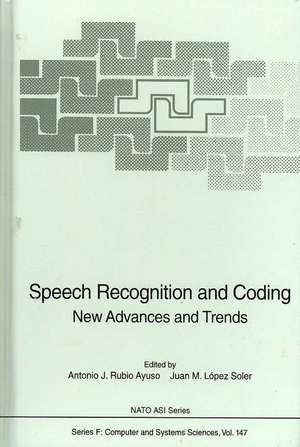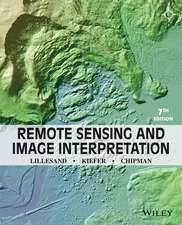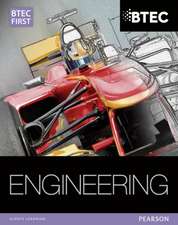Speech Recognition and Coding: New Advances and Trends: NATO ASI Subseries F:, cartea 147
Editat de Antonio J. Rubio Ayuso, Juan M. Lopez Soleren Limba Engleză Hardback – 20 oct 1995
| Toate formatele și edițiile | Preț | Express |
|---|---|---|
| Paperback (1) | 955.56 lei 6-8 săpt. | |
| Springer Berlin, Heidelberg – 5 noi 2012 | 955.56 lei 6-8 săpt. | |
| Hardback (1) | 962.98 lei 6-8 săpt. | |
| Springer Berlin, Heidelberg – 20 oct 1995 | 962.98 lei 6-8 săpt. |
Din seria NATO ASI Subseries F:
- 20%
 Preț: 650.27 lei
Preț: 650.27 lei - 20%
 Preț: 668.55 lei
Preț: 668.55 lei - 20%
 Preț: 992.44 lei
Preț: 992.44 lei - 18%
 Preț: 1239.19 lei
Preț: 1239.19 lei - 20%
 Preț: 1922.81 lei
Preț: 1922.81 lei - 20%
 Preț: 654.37 lei
Preț: 654.37 lei - 18%
 Preț: 1234.00 lei
Preț: 1234.00 lei - 20%
 Preț: 709.78 lei
Preț: 709.78 lei - 20%
 Preț: 656.03 lei
Preț: 656.03 lei - 18%
 Preț: 1854.94 lei
Preț: 1854.94 lei - 20%
 Preț: 374.97 lei
Preț: 374.97 lei - 20%
 Preț: 991.94 lei
Preț: 991.94 lei - 20%
 Preț: 671.02 lei
Preț: 671.02 lei - 20%
 Preț: 1925.96 lei
Preț: 1925.96 lei - 20%
 Preț: 994.73 lei
Preț: 994.73 lei -
 Preț: 389.49 lei
Preț: 389.49 lei - 20%
 Preț: 657.99 lei
Preț: 657.99 lei - 20%
 Preț: 655.20 lei
Preț: 655.20 lei - 18%
 Preț: 1225.31 lei
Preț: 1225.31 lei - 18%
 Preț: 952.09 lei
Preț: 952.09 lei - 20%
 Preț: 332.06 lei
Preț: 332.06 lei - 20%
 Preț: 1284.47 lei
Preț: 1284.47 lei - 20%
 Preț: 644.81 lei
Preț: 644.81 lei -
 Preț: 395.85 lei
Preț: 395.85 lei - 18%
 Preț: 1221.07 lei
Preț: 1221.07 lei - 15%
 Preț: 643.34 lei
Preț: 643.34 lei - 20%
 Preț: 645.47 lei
Preț: 645.47 lei - 20%
 Preț: 1282.98 lei
Preț: 1282.98 lei - 20%
 Preț: 656.36 lei
Preț: 656.36 lei - 20%
 Preț: 1283.31 lei
Preț: 1283.31 lei - 20%
 Preț: 1924.15 lei
Preț: 1924.15 lei - 20%
 Preț: 362.24 lei
Preț: 362.24 lei
Preț: 962.98 lei
Preț vechi: 1174.36 lei
-18% Nou
Puncte Express: 1444
Preț estimativ în valută:
184.26€ • 192.90$ • 152.47£
184.26€ • 192.90$ • 152.47£
Carte tipărită la comandă
Livrare economică 05-19 aprilie
Preluare comenzi: 021 569.72.76
Specificații
ISBN-13: 9783540600985
ISBN-10: 3540600981
Pagini: 532
Ilustrații: XI, 505 p.
Dimensiuni: 155 x 235 x 34 mm
Greutate: 0.95 kg
Ediția:1995
Editura: Springer Berlin, Heidelberg
Colecția Springer
Seria NATO ASI Subseries F:
Locul publicării:Berlin, Heidelberg, Germany
ISBN-10: 3540600981
Pagini: 532
Ilustrații: XI, 505 p.
Dimensiuni: 155 x 235 x 34 mm
Greutate: 0.95 kg
Ediția:1995
Editura: Springer Berlin, Heidelberg
Colecția Springer
Seria NATO ASI Subseries F:
Locul publicării:Berlin, Heidelberg, Germany
Public țintă
ResearchCuprins
I: Acoustic Modeling.- 1 Automatic Recognition of Noisy Speech.- 2 Adaptive Learning in Acoustic and Language Modeling.- 3 Evaluation of ASR Systems, Algorithms and Databases.- 4 Statistical and Discriminative Methods for Speech Recognition.- 5 Automatic Speech Labeling Using Word Pronunciation Networks and Hidden Markov Models.- 6 Heuristic Search Methods for a Segment Based Continuous Speech Recognizer.- 7 Dimension and Structure of the Vowel Space.- 8 Continuous Speech HMM Training System: Applications to Speech Recognition and Phonetic Label Alignment.- 9 HMM Based Acoustic-Phonetic Decoding with Constrained Transitions and Speaker Topology.- 10 Experiments on a Fast Mixture Density Likelihood Computation.- 11 Explicit Modelling of Duration in HMM: an Efficient Algorithm.- 12 Acoustic-Phonetic Decoding of Spanish Continuous Speech with Hidden Markov Models.- 13 HMM-Based Speech Recognition in Noisy Car Environment.- 14 Extensions to the AESA for Finding k-Nearest-Neighbours.- 15 An Efficient Pruning Algorithm for Continuous Speech Recognition.- 16 On the Performance of SCHMM for Isolated Word Recognition and Rejection.- 17 A Speaker Independent Isolated Word Recognition System for Turkish.- 18 The Speech Recognition Research System of the TU Dresden.- 19 A MMI Codebook Design for MVQHMM Speech Recognition.- 20 SLHMM: An ANN Approach for Continuous Speech Recognition.- 21 Medium Vocabulary Audiovisual Speech Recognition.- 22 SLAM: A PC-Based Multi-Level Segmentation Tool.- 23 Durational Modelling in HMM-based Speech Recognition: Towards a Justified Measure.- 24 Rejection in Speech Recognition for Telecommunication Applications.- II: Language Modeling.- 25 A Learning Approach to Natural Language Understanding.- 26 Language Models for Automatic Speech Recognition.- 27Grammatical Inference and Automatic Speech Recognition.- 28 Statistical Modeling of Segmental and Suprasegmental Information.- 29 Search Strategies For Large-Vocabulary Continuous-Speech Recognition.- 30 Two New Approaches to Language Modeling: A Tutorial.- 31 Representing Word Pronunciations as Trees.- 32 Language Models Comparison in a Robot Telecontrol Application.- 33 Keyword Propagation Viterbi Algorithm.- 34 Dialog and Language Modeling in CRIM’s ATIS System.- 35 On the Use of the Leaving-One-Out Method in Statistical Language Modelling.- 36 Application of Grammar Constraints to ASR Using Signature Functions.- 37 CRIM Hidden Markov Model Based Keyword Recognition System.- 38 Modelling Phone-Context in Spanish by Using SCMGGI Models.- 39 Efficient Integration of Context-Free Language Models in Continuous Speech Recognition.- 40 Keyword Spotting, an Application for Voice Dialing.- III: Speech Processing, Analysis and Synthesis.- 41 Telecommunications Applications of Speech Processing.- 42 Disambiguating Hierarchical Segmentations of Speech Signals.- 43 Talker Tracking using two Microphone Pairs and a CrosspowerSpectrum Phase Analysis.- 44 A Text-to-Speech Services Architecture for UNIX.- 45 Comparison of Parametric Spectral Representations for Voice Recognition in Noisy Environments.- 46 Spectral Analysis of Turkish Vowels and a Comparison of Vowel Normalization Algorithms.- 47 Can You Tell Apart Spontaneous and Read Speech if You Just Look at Prosody?.- 48 The Prosodic Marking of Phrase Boundaries: Expectations and Results.- 49 Voice Source State as a Source of Information in Speech Recognition: Detection of Laryngealizations.- 50 Voice Transformations for the Evaluation of Speaker Verification Systems.- 51 Towards a More Realistic Evaluation of Synthetic Speech:A Cognitive Perspective.- 52 A Non-Linear Speech Analysis Based on Modulation Information.- 53 The Recognition Component of the SUNDIAL Project.- IV: Speech Coding.- 54 An Overview of Different Trends on CELP Coding.- 55 Concepts and Paradigms in Speech Coding.- 56 Speech Coding over Noisy Channels.- 57 Lattice and Trellis Coded Quantizations for Efficient Coding of Speech.- 58 8 kbit/sLD-CELP Coding for Mobile Radio.- 59 Subband Long-Term Prediction for LPC-Coders.- 60 On the Use of Interframe Information of Line Spectral Frequencies in Speech Coding.- 61 Speech Coding Using the Karhunen-Lóeve Representation of the Spectral Envelope of Acoustic Subwords.- 62 Excitation Construction for the Robust Low Bit Rate CELP Speech Coder.- 63 A Discrete Cosine Transform Scheme for Low-Delay Wideband Speech Coding.- 64 MOR-VQ for Speech Coding Over Noisy Analog Channels.- 65 Improved CELP Coding Using a Fully Adaptive Excitation Codebook.- V: Vector Quantization and Neural Nets.- 66 Recent Advances in JANUS: A Speech Translation System.- 67 On a Fuzzy DVQ Algorithm for Speech Recognition.- 68 On the Use of Recurrent Neural Networks for Grammar Learning and Word Spotting.- 69 LVQ-based Codebooks in Phonemic Speech Recognition.- 70 Distributed and Local Neural Classifiers for Phoneme Recognition.- 71 A VQ Algorithm Based on Genetic Algorithms and LVQ.- 72 Vector Quantization Based Classification and Maximum Likelihood Decoding for Speaker Recognition.- 73 Evidence Combination in Speech Recognition Using Neural Networks.











